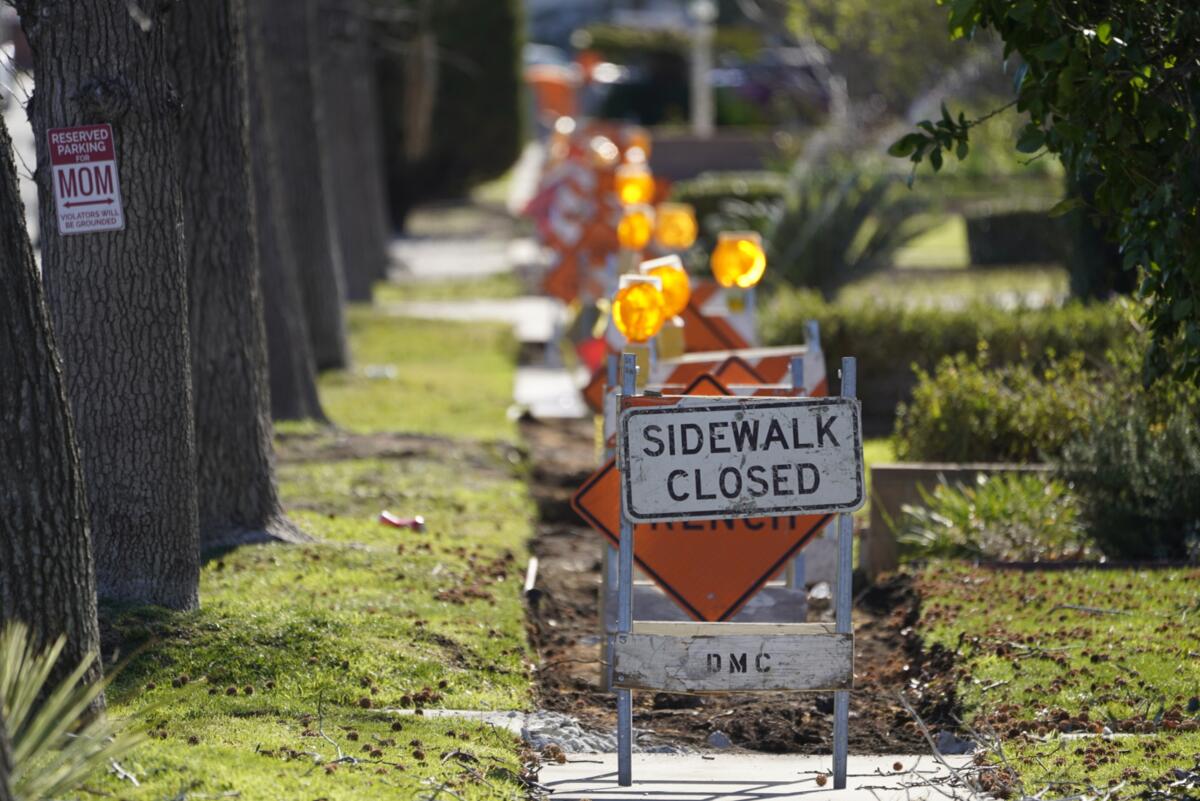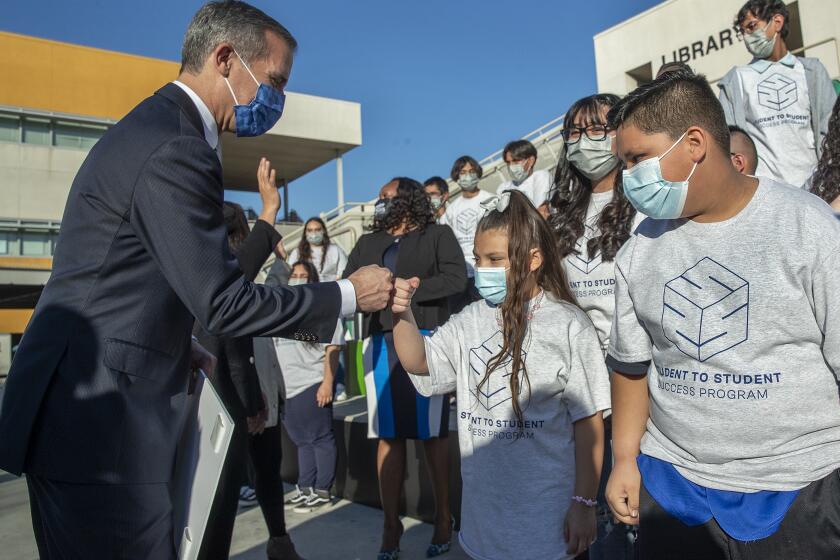After huge pandemic losses, governments see rapid rebound

- Share via
State and local governments lost at least $117 billion of expected revenue early in the COVID-19 pandemic, according to an Associated Press analysis, but many are now awash in record amounts of money, boosted partly by federal aid.
In response to the dramatic turnaround, governors, lawmakers and local officials have proposed a surge in spending as well as a new wave of tax cuts.
“The ultimate effect of the pandemic was a net positive,” said Stephen Parker, assistant city manager of Upland, where sales tax revenue is soaring. “Isn’t that unbelievable? It’s just crazy to think of that.”
Upland, a city of 79,000 in San Bernardino County, was representative of many cities at the outset of the pandemic. It reported an estimated loss of nearly $6.1 million in 2020 — the result of a steep but short-lived national recession and what Parker describes as a “generous” Treasury Department method for calculating losses. That figure was the median amount among more than 900 cities that reported their revenues to the department under the American Rescue Plan Act.
Upland’s financial situation turned around even before the end of 2020, Parker said. Federal COVID-19 stimulus checks played a role. So did a shift in consumer spending to goods instead of services. That lifted city revenue, Parker said, because services often are exempt from sales taxes, while goods are not.
The pandemic relief law championed by Democrats and signed by President Biden last March included $350 billion in aid to states and local governments. The Treasury Department required states, counties and larger cities to file reports last year detailing their initial plans for the money. Those governments also were asked to estimate their losses for 2020 by comparing actual revenue to expected revenue under a Treasury formula.
Though revenue figures were left blank by nearly one-quarter of the roughly 3,700 governments that filed reports, the data nonetheless provide the most comprehensive picture yet of the financial strain on governments during the pandemic’s first year.
More than two-thirds of state and local governments reported at least some losses, ranging from a few thousand dollars in some rural counties to more than $12 billion for the state of Texas, according to the AP’s analysis. The total was $117.5 billion.
The Treasury Department in October declined an AP request to release the revenue-loss data under the federal Freedom of Information Act, saying it would be publicly available later. It recently posted the data on its website. The next reports are due Monday for some governments and April 30 for others.
The department used lost revenue to determine how much flexibility to give governments in spending the aid. Under guidelines issued in May, governments that showed a loss were free to spend an equal amount on almost any government services, including roads and other projects not otherwise allowed under the rules.
A final rule released this month expanded that flexibility by allowing governments to claim up to $10 million of revenue losses, even if actual losses were less.
Upland, which is getting $15 million, plans to use part of its flexible spending to repave parking lots and repair hundreds of sections of sidewalks that might not otherwise have been eligible.
Federal assistance was not the only factor that helped governments bounce back.
The program aims to generate work opportunities for underserved young people between the ages of 16 and 30.
Financial analysts also cite inflation, which pushed up prices and bolstered sales tax collections. Many consumers also had more to spend because of the stimulus checks. A strong stock market drove up capital gains taxes. And an early pandemic rise in unemployment spared many higher earners, who shifted to working from home while continuing to pay income taxes.
In many places, the revenue rebound exceeded pre-pandemic levels. Total state tax revenues from last April through November rose 20% compared with the same period in 2019, according to an Urban Institute report released this month.
For governments that already were financially strained, the pandemic deepened their losses but also resulted in a cash windfall.
The Hudson River Valley city of Poughkeepsie was rated by the New York comptroller as the state’s most financially stressed community in 2020. With a pre-pandemic deficit of about $7 million and no reserves, the city quickly cut spending, sold property, froze hiring and instituted an early retirement program “in a desperate effort to close the gap” when the pandemic began, City Administrator Marc Nelson said.
The city reported a 2020 revenue loss of nearly $4.5 million under the Treasury Department’s formula. It’s getting more than $20 million from the American Rescue Plan. Though the relief money cannot be used to wipe out the deficit, the city plans to make major improvements to parks and swimming pools, including a complete rebuild of a run-down bathhouse that has been relying on portable toilets.
“These are things that would not have been within the city’s ability to take on were it not for the COVID relief money,” Nelson said.
Though they’re spending the federal aid, some Republican officials insist it was unnecessary in light of the rapidly rebounding tax revenue.
Missouri reported an estimated $900-million loss for 2020 but ended its 2021 fiscal year with a record cash balance. Republican Gov. Mike Parson recently proposed a $47-billion budget that is up nearly one-third over the current year because of surging federal and state revenue. He wants to spend more on infrastructure and public employee salaries while also saving more.
“When other states will be using federal dollars to fill spending gaps and budget shortfalls, we will be making investments in the future,” he said in his State of the State address.
In some cases, government losses weren’t as severe as the Treasury numbers might suggest.
Greer County, in rural southwest Oklahoma, reported a 2020 revenue loss of $363,630 — about the national median for counties reporting their revenues. That constituted 10% of the county’s expected revenue under the Treasury Department formula, but it didn’t prompt budget cuts, County Clerk Tiffany Buchanan said.
“The county didn’t feel that much of a loss,” Buchanan said, explaining: “We live on a very tight, strict budget as it is.”
The county plans to use some of its $1.1 million from the American Rescue Plan to help fund the Sheriff’s Office and pay emergency medical personnel.
Some states, including California and Texas, projected large revenue losses at the outset of the pandemic but have since posted big gains.
When it passed a budget early in the pandemic, California had expected the recession to cause a $54-billion deficit. That led officials to defer payments to schools and community colleges and to reduce state employee pay, according to the state’s Treasury report.
Now California is projecting a nearly $46-billion surplus spurred by record tax collections, leaving officials searching for ways to use the money. Gov. Gavin Newsom recently proposed a budget that would expand health coverage to all low-income adults living in the state illegally while simultaneously cutting taxes. The Democratic governor also said a substantial tax rebate was probably in order.
“I will be holding the governor’s feet to the fire and keep him at his word to refund surplus dollars to the taxpayers,” state Sen. Melissa Melendez (R-Lake Elsinore) said.
Associated Press writer Adam Beam contributed to this report.
More to Read
Inside the business of entertainment
The Wide Shot brings you news, analysis and insights on everything from streaming wars to production — and what it all means for the future.
You may occasionally receive promotional content from the Los Angeles Times.











